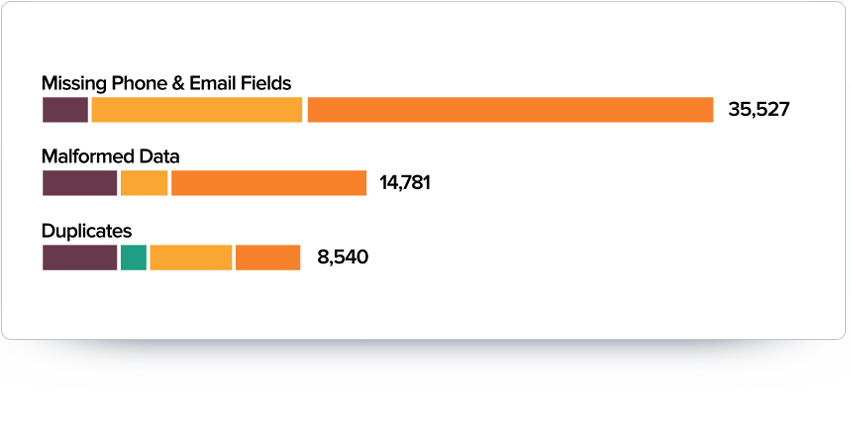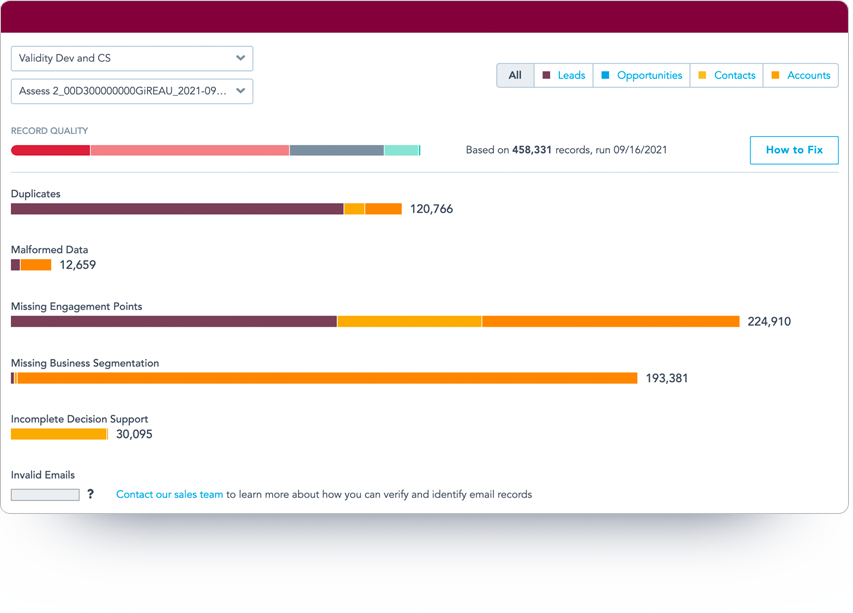Data is a valuable asset for any business. Whether that data involves people, statistics, products, or outcomes, managing this information can further your customer relationship management (CRM) efforts. Once you know how to interpret the data, you can let it work for you to drive more leads, plan for growth, and close more deals.
Data profiling definition
Data profiling is the process of sorting through chunks of information. It analyzes, reviews, and summarizes data, sifting through it to make sense of the information by assigning it value, identifying recurring patterns, and confirming accuracy.
You’ll gain a deeper understanding of your business by identifying missing values, duplicates, errors, outliers, and other points of interest in your data. You can also use the information from data profiling to generate valuable reports that you can share with other departments.
Poor data quality is a recipe for disaster for companies across any and all industries. That’s why data profiling is indispensable to a good quality data strategy.
Harvard Business Review once reported that only 3% of data meet quality standards — and that extremely low number continues to hold true to this day. So, how can companies collect, access, and properly analyze relevant data? The answer is simple: data profiling.
Read on to discover more about data profiling.
Data profiling techniques
Some data types will be profiled differently from others. For example, one technique involves checking for consistency, while another looks at the relationships between data. Some companies may require all methods to make sense of their information, while others may only need one or two.
What are the different types of data profiling?
Not all data profiling is the same. In fact, there are three main types of data profiling that you should familiarize yourself with.
1. Structure profiling
This type of profiling checks your data for consistency and formatting within the structure of the dataset. It also helps you understand the type of data in a field, such as numeric, text, range, or picklist. For example, it can help to identify phone numbers without the correct number of digits or those that may have an “x” or “ext” to denote an extension number. Structure profiling will show you the current state of your data structure and help define the structure moving forward. It can answer important questions, including whether we should keep the extension in the phone field or place it in its own field.
2. Content profiling
This type of profiling prioritizes the data quality. It identifies which data isn’t standardized to fit with the existing data and whether it needs to be fixed. This can include identifying phone numbers without an area code or email addresses missing an “@” character. This type of profiling looks at the accuracy of the values in the fields that hold each data point to identify any systemic data issues.
3. Relationship profiling
This type of profiling analyzes the connections (relationships) between data. This is helpful in understanding data workflows and the fields they are reliant on as well as preserving relationships when moving or migrating data.
Each type of profiling works together to help your organization sort and improve the quality of your data — making it accessible and understandable for business intelligence.
Data profiling steps
When you start to incorporate data profiling into your business, there are steps you’ll need to follow. These steps can assist you in making sense of datasets while providing actionable information you can use to improve your business processes. Going through the steps is relatively easy, and working with high-quality industry tools often simplifies the process further.
The steps include:
- Decide if you need data profiling at the start of projects: To save time and achieve the best and quickest outcomes, determine if you’ll need to use data profiling before every project. With this initial process, you’ll know if the information is suitable for data analysis.
- Gather the relevant sources: If the information is suitable, gather the metadata and your data sources.
- Cleanse the data: The next step of data profiling is cleaning the information by removing errors and duplications and finding anomalies.
- Review the outcome: Once the data profiling tools have sifted through and cleaned the data, you’ll get valuable statistics about the dataset. These statistics can include the frequency of certain data points, quality issues, recurring patterns, and dependencies, as well as the mean, maximum, and minimum values.
For example, suppose you’d like to introduce a certain service that will only suit corporate consumers in the Software as a Service (SaaS) industry. You already have an email list, but you’re not sure which customers on that list will be the ideal candidates for your new service. Perhaps your email list is not categorized by industry or includes overly broad categories.
By using data profiling, the tool can analyze your data, identify invalid emails, and categorize the valid ones, distilling the broad email list into one comprising only usable, validly categorized emails. You can use this data to launch your new service via email announcements.
Profile your Salesforce or Dynamics 365 data with a free DemandTools data quality assessment.

Data profiling vs. data mining
If you’re looking for ways to sort your data and make your working system more manageable, you’ve probably heard of data mining. Data profiling and data mining do have some similarities, but their end goals are different. It’s important to understand how these two concepts differ in order to make the best decision for your business needs.
Data profiling reviews and analyzes your raw data to ensure accuracy. Consider it the first step before moving on to data mining.
Once the raw data is accurately examined and summarized, data mining attempts to gain further insight from it. It involves extracting patterns from large datasets to learn about consumer trends, allowing businesses to respond to changes. In essence, data mining helps companies make critical decisions and is often used in credit risk management, fraud detection, and spam prevention.
Take a look at their summarized differences:
- Data profiling: Data profiling is the process of understanding your data. Data profiling tools analyze characteristics so you can use the information more effectively.
- Data mining: Data mining looks for trends and insights in the data so you can make more effective decisions for your business and customers.
The process of data mining is as follows:
- The data is collected and loaded into data warehouses or cloud storage.
- Teams access the data and determine how to analyze it.
- The data is organized and assessed using custom applications.
- Teams share the findings in easy-to-read graphs or tables.
What are the benefits of data profiling?
Data profiling is the key step between collecting and using your data. It’s a process that enables your business to discover, understand, and organize the data that you’ve acquired.
It helps with:
- Better data quality and credibility
- Predictive data and analytics decisions
- Proactive crisis management
- Organized and centralized sorting
- Business process optimization
- Improving the dataset and data source relationship
- Saving money by eliminating errors
- Highlighting problem areas in the system
- Gaining key insights about trends and opportunities
Each year, data profiling becomes increasingly important as it ensures high-quality data is being collected and used efficiently. It not only helps to find important information that may be hidden within your data but also helps your organization follow data regulations and industry standards.
Similarly, business systems are expected to house increasingly diverse and large amounts of data that need to be report-ready and usable. The quantity of the data — no matter how expansive — will not benefit your organization if it can’t be correctly diagnosed, integrated, and understood for business analysis and strategy.
Important note: In June 2021, Apple announced its plans to introduce Mail Privacy Protection (MPP) for its native Mail client users. This feature prevents email senders from accessing tracking data to engage with customers more accurately. Data profiling can be an effective way to meet the challenge head-on as it prioritizes customer-submitted data that won’t be blocked for certain users in the future. Learn more about the mail privacy protection update here.
53%
53% of organizations say that missing or incomplete data seriously impairs their ability to leverage their CRM system to its full effect.
*(source: Validity Research: State of CRM Data Health 2022)
Most common data profiling challenges
The most common difficulty that faces data profiling is the large amounts of data that companies often need to process. For many, their data systems contain information from years before, which may not have been standardized or formatted — resulting in thousands of errors.
More challenges include:
- Incomplete data: Older data may suffer from poor quality as there may be missing information in important fields.
- Inadequate profiling tools: If your data profiling tools aren’t expansive enough, it may become too difficult to analyze the full data source completely or thoroughly.
- Manual data profiling: This kind of profiling may be incomplete and resource-intensive, yielding low returns for high efforts.
- Speed of the data: If data is coming in fast, it may be a challenge to keep up with data profiling, highlighting the need for quick action.
Many of these data profiling challenges can be met head-on with how you choose to conduct your business’s profiling.
DemandTools Assess helps businesses profile their CRM data.

Data profiling best practices: How is data profiling conducted?
Data profiling relies on a wide variety of techniques to sort through a company’s data. These techniques include consistent duplicate scanning, field usage tracking and data quality exception reporting.
By identifying different types of data and recognizing patterns, data profiling can then be used to highlight any potential problems that are harming your organization’s data quality. These errors can vary from misspellings to incomplete information to duplicate data.
Profiling should also include the phase for documenting workflows, the intended use for each field, and data access thresholds.
Due to the intricate nature and large volume of data that profiling needs to sort through, profiling solutions are often needed to ensure good-quality data.
55%
of businesses use manual processes to identify and correct data quality issues
*(source: Validity Research: State of CRM Data Health 2022)
Data profiling tools and solutions
Data is your most valuable asset, which is why most companies choose to implement purpose-built data management software that can handle data sets of varying sizes and complexity. It’s more time and cost-effective than manual data profiling, which can overwhelm department resources and has the added potential of human error. If you’re interested in reading more about the connection between data quality and CRM adoption, read our post here.
To help companies evolve with the future of data, Validity’s DemandTools is a versatile and secure platform that cleans and maintains CRM data efficiently and — most importantly — accurately. To learn more and discover how you can access report-ready data for improved ROI, check out DemandTools here.
Try DemandTools for free today!